Abstract
An avian influenza A virus, A/Mallard/NY/6750/78(H2N2), was restricted in in replication in the respiratory tract of squirrel monkeys. Avian-human influenza A reassortant viruses possessing the six RNA segments coding for nonsurface proteins (i.e., internal genes) of this avian virus were as restricted in replication in squirrel monkeys as their avian influenza parent. These findings indicated that restriction of replication of the avian influenza virus is a function of one or more of its internal genes. For an investigation of which of the avian influenza genes was responsible for restricted replication in the respiratory tract of primates, reassortant viruses were produced that contained human influenza virus surface antigens from the A/Udorn/72(H3N2) virus and one or more of the internal genes derived from the avian influenza virus parent. Avian-human reassortant influenza A viruses containing only the nucleoprotein or matrix protein RNA segment from the avian influenza virus parent were as restricted in their growth as an avian-human influenza reassortant virus containing each of the six avian influenza internal genes. In addition, an avian-human influenza reassortant virus possessing only the avian RNA 1 and nonstructural genes (which by themselves do not specify restricted replication) manifested a significant reduction of virus replication in squirrel monkey tracheas. Thus, the avian nucleoprotein and matrix genes appear to play a major role in the host range restriction exhibited by the A/Mallard/78 virus and its reassortants, but the combination of RNA 1 and nonstructural genes also contributes to restriction of replication.
Full text
PDF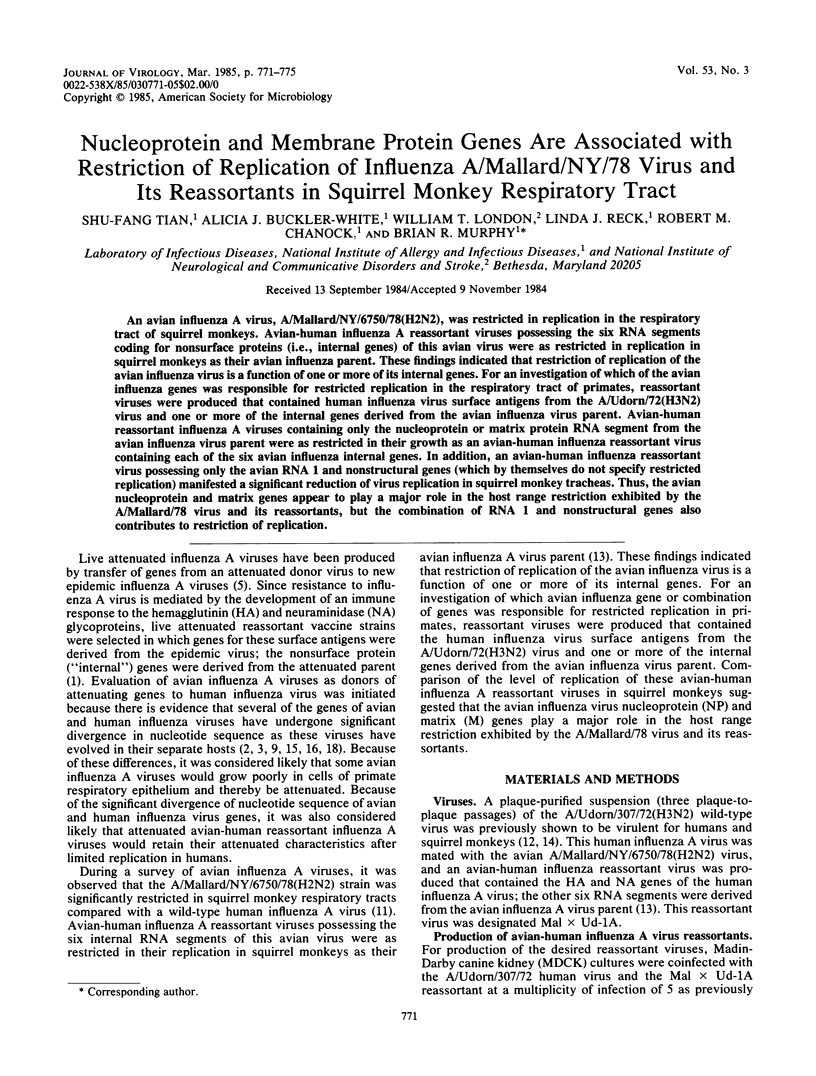
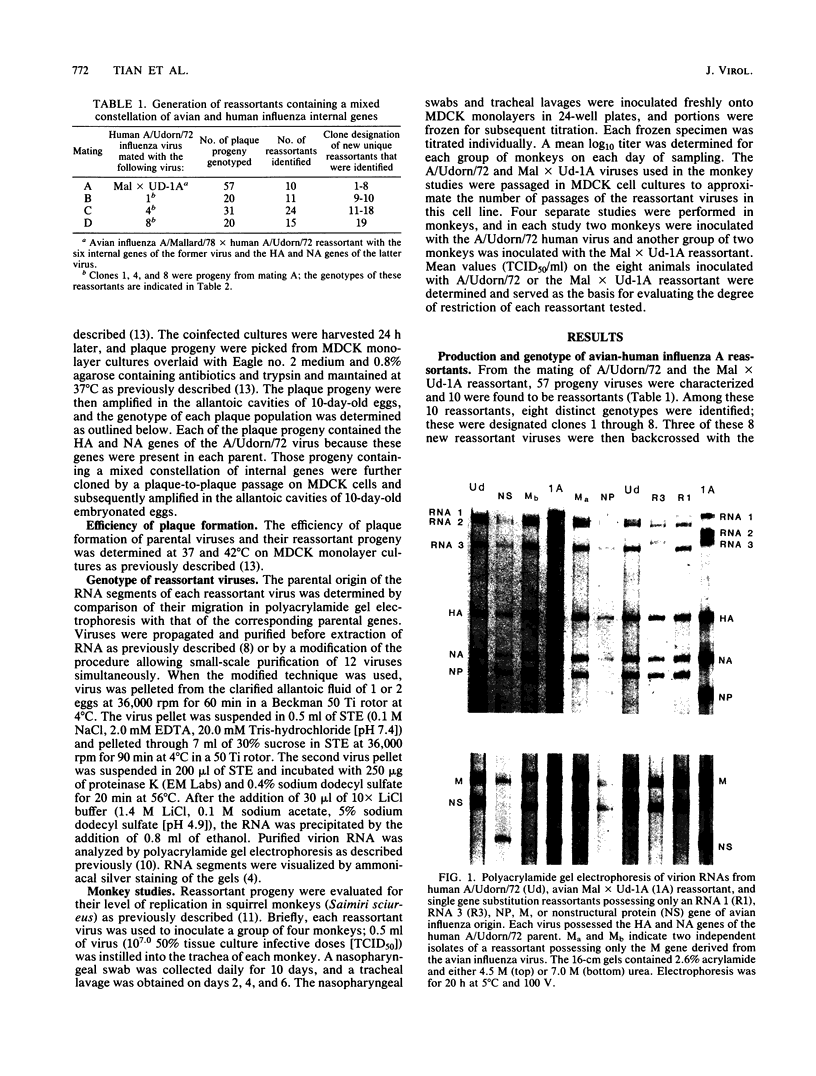
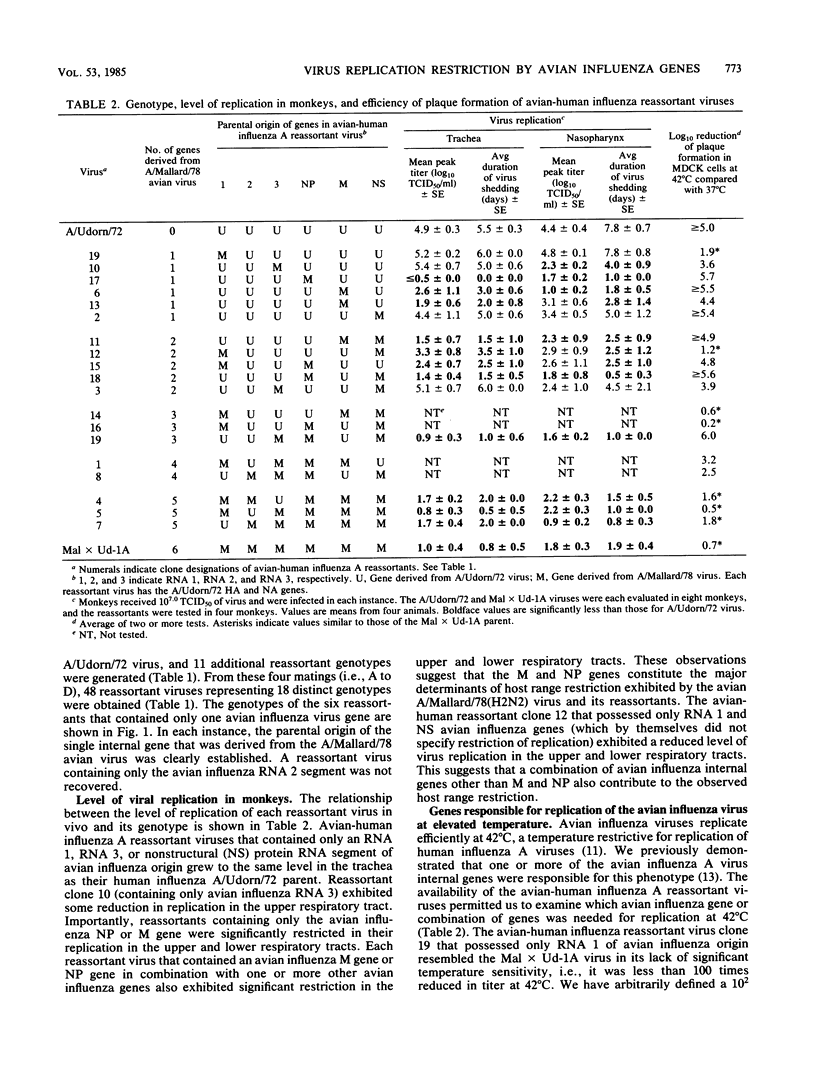
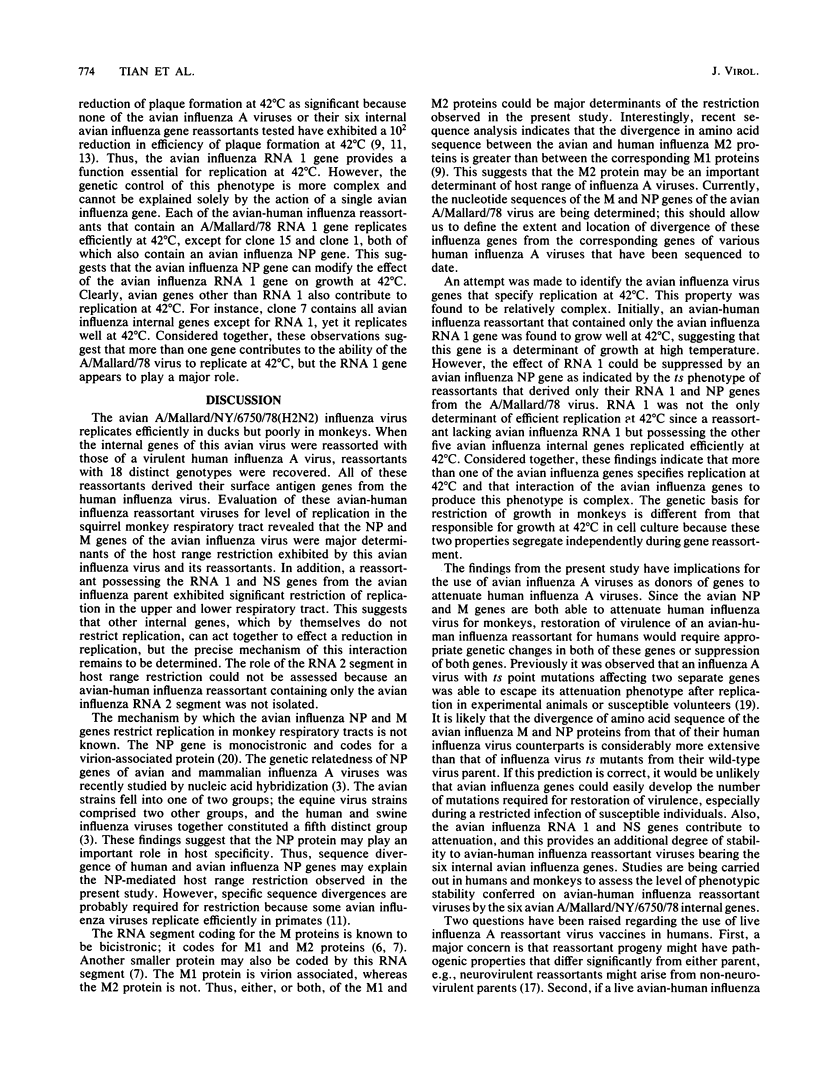
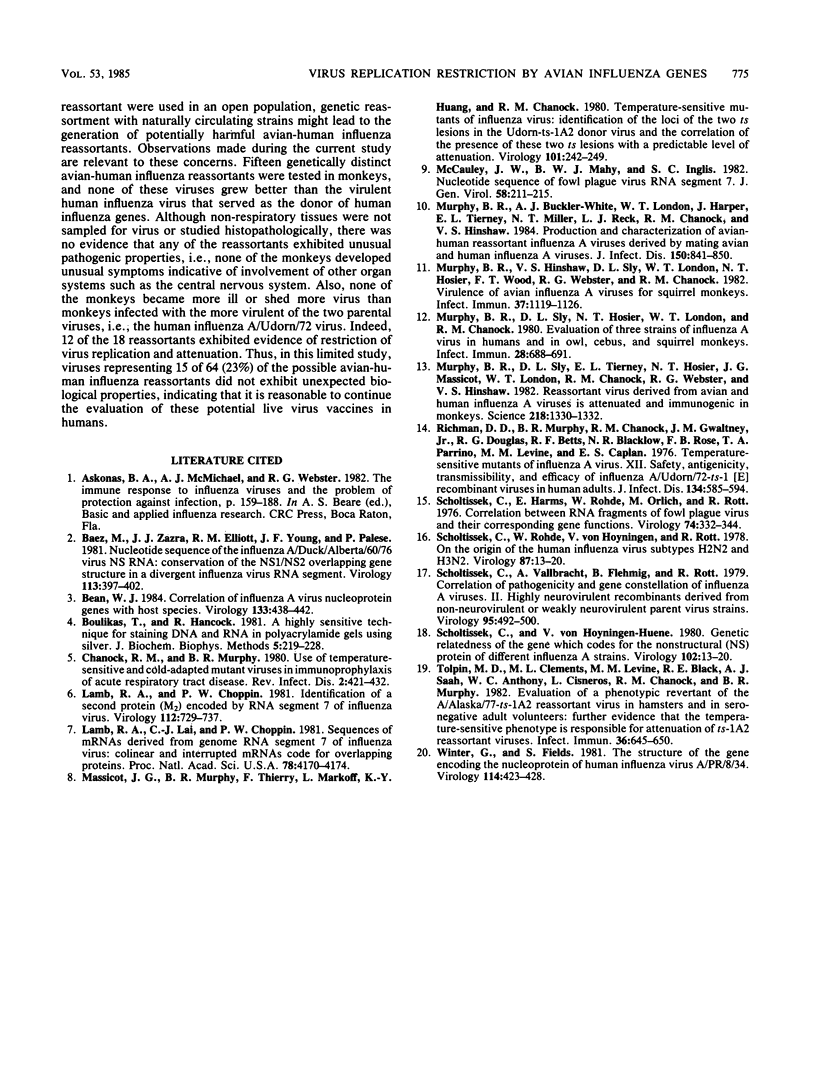
Images in this article
Selected References
These references are in PubMed. This may not be the complete list of references from this article.
- Baez M., Zazra J. J., Elliott R. M., Young J. F., Palese P. Nucleotide sequence of the influenza A/duck/Alberta/60/76 virus NS RNA: conservation of the NS1/NS2 overlapping gene structure in a divergent influenza virus RNA segment. Virology. 1981 Aug;113(1):397–402. doi: 10.1016/0042-6822(81)90166-5. [DOI] [PubMed] [Google Scholar]
- Bean W. J. Correlation of influenza A virus nucleoprotein genes with host species. Virology. 1984 Mar;133(2):438–442. doi: 10.1016/0042-6822(84)90410-0. [DOI] [PubMed] [Google Scholar]
- Boulikas T., Hancock R. A highly sensitive technique for staining DNA and RNA in polyacrylamide gels using silver. J Biochem Biophys Methods. 1981 Oct;5(4):219–228. doi: 10.1016/0165-022x(81)90046-4. [DOI] [PubMed] [Google Scholar]
- Chanock R. M., Murphy B. R. Use of temperature-sensitive and cold-adapted mutant viruses in immunoprophylaxis of acute respiratory tract disease. Rev Infect Dis. 1980 May-Jun;2(3):421–432. doi: 10.1093/clinids/2.3.421. [DOI] [PubMed] [Google Scholar]
- Lamb R. A., Choppin P. W. Identification of a second protein (M2) encoded by RNA segment 7 of influenza virus. Virology. 1981 Jul 30;112(2):729–737. doi: 10.1016/0042-6822(81)90317-2. [DOI] [PubMed] [Google Scholar]
- Lamb R. A., Lai C. J., Choppin P. W. Sequences of mRNAs derived from genome RNA segment 7 of influenza virus: colinear and interrupted mRNAs code for overlapping proteins. Proc Natl Acad Sci U S A. 1981 Jul;78(7):4170–4174. doi: 10.1073/pnas.78.7.4170. [DOI] [PMC free article] [PubMed] [Google Scholar]
- Massicot J. G., Murphy B. R., Thierry F., Markoff L., Huang K. Y., Chanock R. M. Temperature-sensitive mutants of influenza virus. Identification of the loci of the two ts lesions in the Udorn-ts-1A2 donor virus and the correlation of the presence of these two ts lesions with a predictable level of attenuation. Virology. 1980 Feb;101(1):242–249. doi: 10.1016/0042-6822(80)90499-7. [DOI] [PubMed] [Google Scholar]
- McCauley J. W., Mahy B. W., Inglis S. C. Nucleotide sequence of fowl plague virus RNA segment 7. J Gen Virol. 1982 Jan;58(Pt 1):211–215. doi: 10.1099/0022-1317-58-1-211. [DOI] [PubMed] [Google Scholar]
- Murphy B. R., Buckler-White A. J., London W. T., Harper J., Tierney E. L., Miller N. T., Reck L. J., Chanock R. M., Hinshaw V. S. Avian-human reassortant influenza A viruses derived by mating avian and human influenza A viruses. J Infect Dis. 1984 Dec;150(6):841–850. doi: 10.1093/infdis/150.6.841. [DOI] [PubMed] [Google Scholar]
- Murphy B. R., Hinshaw V. S., Sly D. L., London W. T., Hosier N. T., Wood F. T., Webster R. G., Chanock R. M. Virulence of avian influenza A viruses for squirrel monkeys. Infect Immun. 1982 Sep;37(3):1119–1126. doi: 10.1128/iai.37.3.1119-1126.1982. [DOI] [PMC free article] [PubMed] [Google Scholar]
- Murphy B. R., Sly D. L., Hosier N. T., London W. T., Chanock R. M. Evaluation of three strains of influenza A virus in humans and in owl, cebus, and squirrel monkeys. Infect Immun. 1980 Jun;28(3):688–691. doi: 10.1128/iai.28.3.688-691.1980. [DOI] [PMC free article] [PubMed] [Google Scholar]
- Murphy B. R., Sly D. L., Tierney E. L., Hosier N. T., Massicot J. G., London W. T., Chanock R. M., Webster R. G., Hinshaw V. S. Reassortant virus derived from avian and human influenza A viruses is attenuated and immunogenic in monkeys. Science. 1982 Dec 24;218(4579):1330–1332. doi: 10.1126/science.6183749. [DOI] [PubMed] [Google Scholar]
- Richman D. D., Murphy B. R., Chanock R. M., Gwaltney J. M., Jr, Douglas R. G., Betts R. F., Blacklow N. R., Rose F. B., Parrino T. A., Levine M. M. Temperature-sensitive mutants of influenza A virus. XII. Safety, antigenicity, transmissibility, and efficacy of influenza A/Udorn/72-ts-1[E] recombinant viruses in human adults. J Infect Dis. 1976 Dec;134(6):585–594. [PubMed] [Google Scholar]
- Scholtissek C., Harms E., Rohde W., Orlich M., Rott R. Correlation between RNA fragments of fowl plague virus and their corresponding gene functions. Virology. 1976 Oct 15;74(2):332–344. doi: 10.1016/0042-6822(76)90340-8. [DOI] [PubMed] [Google Scholar]
- Scholtissek C., Rohde W., Von Hoyningen V., Rott R. On the origin of the human influenza virus subtypes H2N2 and H3N2. Virology. 1978 Jun 1;87(1):13–20. doi: 10.1016/0042-6822(78)90153-8. [DOI] [PubMed] [Google Scholar]
- Scholtissek C., Vallbracht A., Flehmig B., Rott R. Correlation of pathogenicity and gene constellation of influenza A viruses. II. Highly neurovirulent recombinants derived from non-neurovirulent or weakly neurovirulent parent virus strains. Virology. 1979 Jun;95(2):492–500. doi: 10.1016/0042-6822(79)90503-8. [DOI] [PubMed] [Google Scholar]
- Scholtissek C., von Hoyningen-Huene V. Genetic relatedness of the gene which codes for the nonstructural (NS) protein of different influenza A strains. Virology. 1980 Apr 15;102(1):13–20. doi: 10.1016/0042-6822(80)90065-3. [DOI] [PubMed] [Google Scholar]
- Tolpin M. D., Clements M. L., Levine M. M., Black R. E., Saah A. J., Anthony W. C., Cisneros L., Chanock R. M., Murphy B. R. Evaluation of a phenotypic revertant of the A/Alaska/77-ts-1A2 reassortant virus in hamsters and in seronegative adult volunteers: further evidence that the temperature-sensitive phenotype is responsible for attenuation of ts-1A2 reassortant viruses. Infect Immun. 1982 May;36(2):645–650. doi: 10.1128/iai.36.2.645-650.1982. [DOI] [PMC free article] [PubMed] [Google Scholar]
- Winter G., Fields S. The structure of the gene encoding the nucleoprotein of human influenza virus A/PR/8/34. Virology. 1981 Oct 30;114(2):423–428. doi: 10.1016/0042-6822(81)90223-3. [DOI] [PubMed] [Google Scholar]



